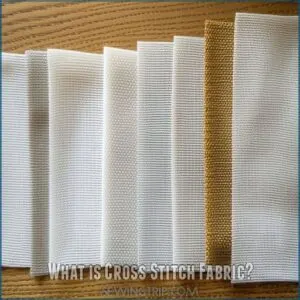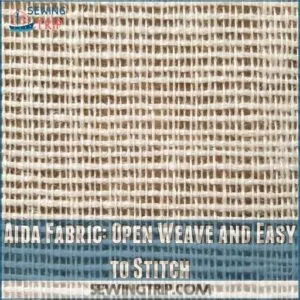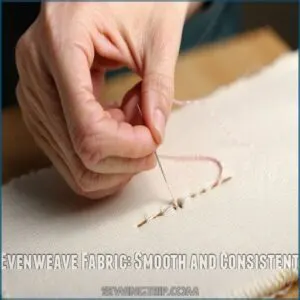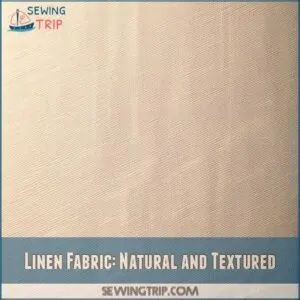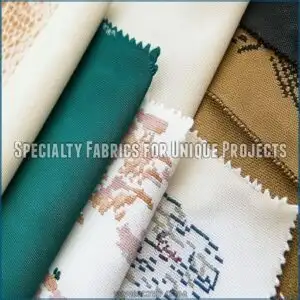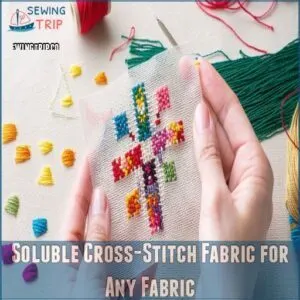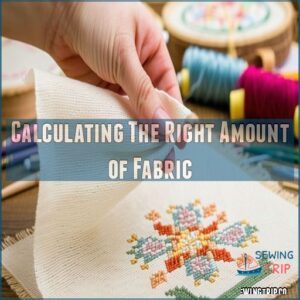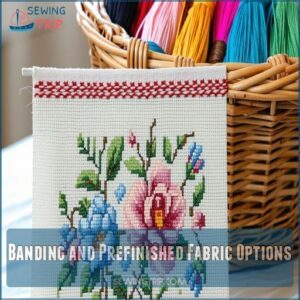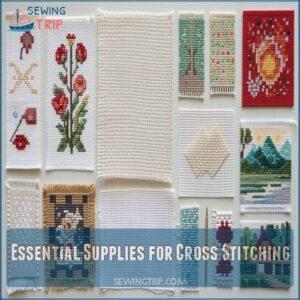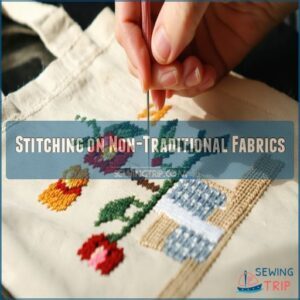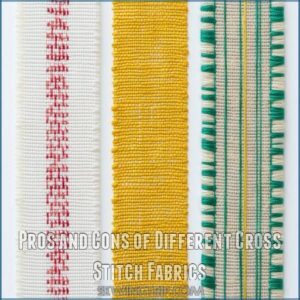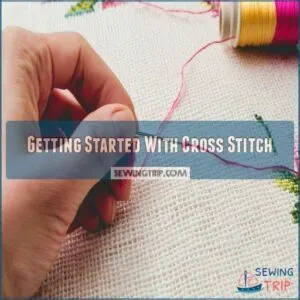This site is supported by our readers. We may earn a commission, at no cost to you, if you purchase through links.
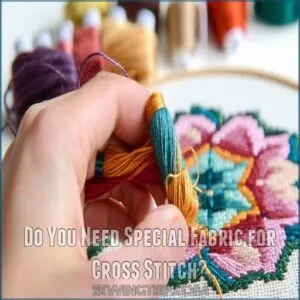 You don’t need special fabric for cross stitch, but using it makes stitching a breeze!
You don’t need special fabric for cross stitch, but using it makes stitching a breeze!
Aida fabric, with its evenly spaced holes, is like training wheels for your needle—perfect for beginners.
Evenweave and linen offer more precision and are great for intricate designs. They help your stitches land right where they should.
While you can technically stitch on any fabric (your old T-shirt, perhaps?), using a specialized fabric keeps your work neat and satisfying. Plus, think of the confidence boost!
Wondering whether Aida’s your style or leaning toward linen? Let’s explore the fabric world a bit deeper to find out.
Table Of Contents
- Key Takeaways
- What is Cross Stitch Fabric?
- Do You Need Special Fabric for Cross Stitch?
- Types of Cross Stitch Fabric
- Choosing The Right Fabric for Your Project
- Yardage and Prefinished Options
- Essential Supplies for Cross Stitching
- Stitching on Non-Traditional Fabrics
- Pros and Cons of Different Cross Stitch Fabrics
- Getting Started With Cross Stitch
- Mastering Cross Stitch Techniques
- Frequently Asked Questions (FAQs)
- Conclusion
Key Takeaways
- You don’t need special fabric for cross stitch, but using options like Aida, evenweave, or linen makes the process easier and cleaner.
- Aida is perfect for beginners due to its evenly spaced holes, while evenweave and linen offer precision and texture for more intricate designs.
- Choose fabric based on your project’s complexity and personal preferences; each type provides unique textures and finishes.
- Using the right fabric boosts confidence and helps ensure your work looks neat and professional, enhancing your overall stitching experience.
What is Cross Stitch Fabric?
When you’re starting with cross stitch, choosing the right fabric is like picking the perfect canvas for your masterpiece.
Cross stitch fabric comes in different types like Aida, evenweave, and linen, each offering unique textures and challenges to suit your skill level and project needs.
Aida Fabric for Beginners
So, you’re diving into cross stitch? Awesome! Aida fabric‘s your best friend, especially if you’re just starting.
It’s basically the comfy couch of cross-stitch fabrics—super forgiving. That even weave makes those little X’s a breeze. Aida comes in different counts (14 count is popular for beginners), affecting stitch tension. Choosing the right Aida count is half the battle.
Grab a hoop, some thread, and let’s get stitching! Don’t forget pattern selection; simple is key when you’re starting.
Evenweave Fabric for Precision
If you’re aiming for precision, evenweave fabric is your go-to.
With its consistent thread count, it allows for clear fractional stitches, making your cross stitch patterns pop.
Unlike Aida cloth, evenweave provides a smoother surface ideal for intricate designs.
You’ll need to master thread tension and pattern adaptation, but the reward is a seamless, professional look that blends beautifully.
Linen Fabric for Advanced Stitching
Linen fabric offers a unique texture, perfect for advanced stitching techniques.
While evenweave provides precision, linen challenges with its delightful quirks, like slubs and varying thread thickness.
This fabric demands patience and rewards with elegant results.
Here’s why linen is a favorite:
- Texture adds character
- Perfect for fractional stitches
- Requires skillful pattern selection
- Demands attention in finishing techniques
- Offers a classic beauty unmatched by Aida or evenweave
Do You Need Special Fabric for Cross Stitch?
While understanding different cross stitch fabrics is important, you might wonder if special fabric is truly necessary.
Cross stitch projects can be done on various fabric counts, from beginner-friendly Aida cloth to more advanced options.
What matters is your project’s complexity and personal preference.
You can also cross stitch on regular fabric using techniques like temporary stitching grids, which can add versatility to your projects.
Using specific cross stitch fabric types can enhance your work by offering different textures and finishes.
But don’t stress; even basic fabrics from cross stitch kits can yield beautiful results.
Ultimately, choosing the right cross stitch fabric enhances your creative journey.
Types of Cross Stitch Fabric
Choosing the right thread count, such as a full-stitch look or a pencil-drawing style, is crucial for achieving the desired visual effect in your cross stitch project learn more about thread count techniques here. Choosing the right fabric for cross stitch can be as important as picking your favorite thread color.
You’ll find various options like Aida, Evenweave, Linen, and specialty fabrics, each offering unique qualities for your artistic touch.
Aida Fabric: Open Weave and Easy to Stitch
Ever tried Aida fabric for cross stitch?
With its open weave and easy-to-see holes, this fabric’s a real game-changer for beginners.
The typical Aida count is 14, perfect for getting the hang of stitch tension and fabric quality.
Whether you use a hoop or not, Aida fabric makes beginner projects a breeze, helping you enjoy mastering cross stitch.
Evenweave Fabric: Smooth and Consistent
Evenweave fabric offers a balanced texture, making it a staple for dedicated cross stitchers.
With a higher thread count than Aida, it’s perfect for patterns needing precision.
Popular counts include:
- 25, 28, and 32 counts: ideal for fine details
- Blends of cotton and rayon: smooth and versatile
- Great for stitching over two threads
- Fractional stitches are a breeze
Linen Fabric: Natural and Textured
Linen fabric offers a beautiful, natural texture for your cross-stitch projects. It’s a bit trickier than Aida cloth, but the results are stunning! You’ll love the subtle slubs and variations in the weave. Here’s a quick comparison:
| Fabric Type | Stitch Count | Texture | Difficulty |
|---|---|---|---|
| Aida | 14-20 | Even, open weave | Easy |
| Evenweave | 25-32 | Smooth, consistent | Moderate |
| Linen | 28-32 | Irregular, textured | Advanced |
Linen fabric care is simple—hand-washing is best. Explore linen project ideas for inspiration! Higher linen stitch count means finer detail.
Specialty Fabrics for Unique Projects
You’re exploring cross-stitch fabric options beyond the basics.
Specialty fabrics spice up projects, offering fresh flair: Check out unique cross stitch fabric for inspiration on taking your stitching to the next level.
- Hand-dyed fabrics give your work unique color patterns.
- Metallic threads add a shimmering touch.
- Sparkly textures create eye-catching effects.
- Unique effects make your project stand out.
- Fabric blending lets you mix materials for a dynamic look.
Try these for a creative twist!
Soluble Cross-Stitch Fabric for Any Fabric
Think of soluble cross-stitch fabric as your secret weapon for creative endeavors, making it easy to work with various embroidery floss colors and weights like those in our free pattern library.
This dissolvable grid lets you transfer any design onto virtually any fabric, expanding your embroidery options.
Perfect for when Aida fabric isn’t the answer, it offers imaginative project possibilities.
Simply stitch on the grid and wash it away—like magic, only your vibrant design remains!
Choosing The Right Fabric for Your Project
Choosing the right fabric for your cross-stitch project can feel a bit like choosing the right socks—it’s all about comfort and suitability.
You’ll want to think about the pattern’s complexity, how you plan to display the finished piece, and match your fabric’s color to your thread.
All while balancing your skill level with the fabric’s difficulty.
Consider The Pattern Complexity
When choosing fabric for cross stitch, consider the pattern complexity.
Detailed cross stitch patterns often mean more fractional stitches, color changes, and higher stitch counts.
Aida cloth, with its visible grid, suits simple designs.
For intricate ones, go for evenweave or linen that’s smoother and finer.
Match the fabric count with your pattern’s detail to make stitching a breeze.
Think About The Final Display and Use
Planning to hang your cross-stitch creation on the living room wall? Think about the display location and how the project size fits the space. Here’s what to keep in mind:
- Framing options: Will it need special care?
- Desired texture: Aida fabric offers crisp lines.
- Finished work look: Does the fabric count match?
- Long-term beauty: Choose fabric wisely.
Match Fabric Color to Thread Colors
Choosing the right cross stitch fabric color? It’s like picking an outfit—coordinate your color palettes!
DMC threads come in endless shades, so make sure your fabric enhances them rather than clashes.
Aida cloth helps—its neutral tones give thread colors a stage.
It’s all about balance, making your stitches pop like a showstopper.
Color matching tips save the day!
Balance Skill Level With Fabric Difficulty
Picking the right cross-stitch fabric is key! Your skill level directly impacts your fabric choice. Don’t jump into a complex project with linen; start with beginner-friendly fabrics.
Here’s a quick guide:
- Beginners: Stick with Aida cloth (14-count is perfect).
- Intermediate: Try evenweave fabrics (28-count).
- Advanced: Tackle linen (28-32 count) for a challenge.
- Project ambition matters! Match fabric difficulty to your skills for a satisfying experience.
Yardage and Prefinished Options
When planning your cross-stitch project, deciding between buying fabric by the yard or choosing prefinished options can impact both convenience and creativity.
If you’ve ever found yourself unroll yards of fabric only to realize you’ve got way more than you need, you’re not alone!
Calculating The Right Amount of Fabric
Wondering how much fabric you’ll need for your cross-stitch masterpiece? It’s simpler than you think. Start by considering your pattern size and project dimensions.
Factor in your fabric count and stitch count—are you stitching over one or two threads? Don’t forget a margin allowance for framing, typically a couple of inches on each side.
Here’s a handy table to guide you:
| Project Type | Pattern Size | Fabric Count | Margin Allowance |
|---|---|---|---|
| Small Project | 5×5 inches | 14-count | 2 inches |
| Medium Project | 10×10 inches | 16-count | 3 inches |
| Large Project | 15×15 inches | 18-count | 4 inches |
| Extra Large | 20×20 inches | 20-count | 5 inches |
Keep these tips in mind, and you’ll have the perfect cross-stitch fabric ready for your project!
Banding and Prefinished Fabric Options
When planning your cross-stitch project, consider prefinished fabric options and banding for an easy start. Keep in mind that standard fabric lengths, how big is a yard of fabric, can affect how you approach your project, especially if you’re buying extra for potential shrinkage or pattern matching.
Prefinished kits come with everything you need, like pre-cut fabric sizes that match your project.
Here are some options to keep in mind:
- Stitching band: Perfect for bookmarks or straps with Aida fabric.
- Fabric banding: Adds a decorative edge for a polished look.
- Aida fabric options: Various counts for different skill levels.
- Prefinished kits: Include fabric, thread, and pattern for stress-free stitching.
- Pre-cut fabric packs: Save time and make sure you have the right size.
With these choices, your creative journey is off to a great start!
Essential Supplies for Cross Stitching
When you’re ready to start cross-stitching, gathering the right supplies is essential, even if you’re sometimes tempted to use whatever’s lying around.
You’ll need special needles, high-quality embroidery floss, and tools to keep things tight and tidy—because no one wants a wonky stitch!
Choosing The Right Needles for Your Fabric
After figuring out how much fabric you need, picking the right needle becomes your next move.
You’ve got to think about needle size matching your fabric count.
Smaller counts, like 14-count Aida, typically work best with larger needles, while finer fabrics need a smaller one.
You can find a wide variety of sizes and types of needles for cross stitching on this website, so be sure to explore your options.
Look for a needle with a blunt point to glide smoothly through the cloth, keeping your stitches tidy.
Selecting High-Quality Embroidery Floss
Choosing the right embroidery floss is like picking the perfect spice for a dish—it makes all the difference.
DMC vs. Anchor, both offer vibrant colors and reliable thread count.
Consider colorfastness and fiber content to prevent fading, and store your floss properly.
Aida cloth pairs beautifully with these, ensuring your cross stitch fabric stays vibrant and durable.
Hoops, Frames, and Tension Tools
Because even stitching is key, you’ll need the right tools for tension control.
Hoop types vary; consider these: 1. Plastic hoops are budget-friendly, 2. Wooden hoops offer more grip, and 3. Q-snaps provide adjustable tension.
Frame alternatives exist, but hoops prevent cross stitch fabric stretching.
Choosing the right hoop size depends on your project; a larger hoop is better for bigger projects.
Proper tension is essential, preventing fabric wrinkles and ensuring even stitches on your Aida cloth.
Marking Tools and Stitch Counters
Keeping your cross-stitch project organized is like having a trusty flashlight in the dark—a must-have for smooth sailing.
Use marking tools to outline patterns on Aida fabric; they’ll help you avoid a tangled mess.
Stitch counters, your project companions, simplify counting stitches and fabric count.
A little planning with these can prevent chaos and keep your creativity flowing!
Stitching on Non-Traditional Fabrics
Ever considered cross-stitching on a tote bag or a t-shirt?
It’s a bit like cooking dinner without a recipe—you can definitely do it, but you’ll need to make some adjustments for the best results.
Adapting Patterns for Different Fabric Types
Switching to a different cross stitch fabric might feel like trying on new shoes—exciting yet a bit intimidating.
Adjust your pattern to match the fabric count and stitch count of the new fabric.
For Aida cloth lovers, start with cross stitch fabric for beginners.
Remember, a thoughtful fabric selection makes sure your pattern size and grid size fit perfectly, making your masterpiece shine!
Adjusting Tension and Stitch Size
Consistent stitch size and even tension turn cross stitch into a relaxing escape, rather than a tangled mess.
Adjusting tension involves playing with hoop size or using a different needle gauge.
Try practicing on Aida cloth to get a feel for how it reacts.
It’s like finding just the right tightness for a perfect shoelace bow.
Dealing With Fabric Stretch and Distortion
When working with fabric stretch and distortion in cross-stitch, especially on non-traditional fabrics, try preventing this by maintaining firm fabric tension.
Hooping techniques like using a snug hoop can help, but occasionally adjusting stitches can also make a difference.
Prep your fabric ahead to minimize movement, letting evenweave fabric or Aida cloth showcase your artistry without a hitch.
Finishing and Framing Considerations
After combatting fabric stretch, think about finishing your masterpiece with the right framing styles.
Choose fluffy matting options to make Aida cloth pop, or backing choices that keep everything snug.
Consider unique display ideas that match your style while using conservation methods to last.
Whether you’re using beginner-friendly cross stitch fabric counts or experimenting with others, framing completes your art.
Pros and Cons of Different Cross Stitch Fabrics
You’ll discover that each fabric—Aida, evenweave, and linen—offers a unique set of advantages and disadvantages, influencing everything from ease of stitching to the final project’s look and feel.
Consider factors like how easily you can work with the fabric, the finished project’s appearance, its durability, and of course, the cost, before making your choice.
Ease of Use and Learning Curve
Tackling non-traditional fabrics is like dancing on a tightrope, balancing creativity with technique.
But what about the traditional stuff?
Beginner-friendly fabrics like Aida are as welcoming as old friends, offering visible grids that make stitch counting a breeze.
Evenweave fabric demands finesse but can enhance your skills.
For those chasing mastery, linen fabric requires patience, offering growth through its challenges.
Visual Appeal and Texture
Choosing the right cross stitch fabric can affect how your project shines.
Aida cloth is beloved for its clear holes and easy stitch placement.
Evenweave fabric offers a smooth look if you’re chasing even stitches.
For those craving texture, linen provides a natural, charming vibe.
Your fabric choice impacts stitch definition, color impact, and overall visual appeal.
Durability and Longevity of Finished Projects
You might prioritize visual appeal, but don’t overlook how your fabric choice impacts durability and longevity.
Aida cloth is sturdy, perfect for beginners, but evenweave and linen boast elegance and resilience against aging.
Pay attention to wash care, framing, and storage.
Remember, the right cross stitch fabric weight makes sure your masterpiece stands the test of time.
Cost Considerations for Various Fabric Types
Considering the durability of your finished cross-stitch, let’s chat about budget.
Aida cloth is affordable, especially for beginners desiring value for money.
Fancy linen fabric like Zweigart can hit your pocket more due to quality and texture.
Keep an eye on the fabric’s price per square inch.
Remember: fabric weight influences cost as well!
Getting Started With Cross Stitch
When you’re ready to start cross-stitching, gathering your supplies is the first step.
So grab your Aida cloth, colorful threads, and trusty hoop.
Don’t stress over perfection; start with simple patterns.
With practice and patience, you can master intricate stitches like those used in crewel embroidery techniques, and you’ll be creating stunning designs in no time.
Gather Your Supplies
Before you start cross-stitch, gather your essentials like Aida cloth or a fabric of your choice.
Invest in quality threads, like DMC or Anchor, to make those patterns pop.
Choose the right needles for your fabric type, whether it’s aida, evenweave, or linen.
Don’t forget hoops and marking tools for keeping your stitches neat and precise!
Choose The Right Fabric
A key step is choosing the right cross stitch fabric.
Your fabric choice dramatically impacts your project.
Consider these factors:
- Fabric count (higher counts mean finer detail).
- Project complexity (beginners should start with Aida cloth).
- Your budget (linen’s pricier than Aida).
- Desired fabric texture (smooth evenweave or rustic linen?).
Happy stitching!
Select High-Quality Threads
Picking excellent threads is like finding the perfect dance partner for your Aida cloth.
DMC and Anchor embroidery floss are stars, offering vibrant colors and smooth stitches.
They protect against fading and fraying, bringing your creations to life.
Think about your thread count and color matching—these choices make your cross stitch a standout in any room.
Understand Cross-Stitch Patterns
Mastering cross-stitch patterns is like cracking a secret code.
Symbols represent stitch types, while color keys guide you through thread options.
To get started, you can create your own unique pattern by selecting a design, tracing it onto grid paper, and choosing a color scheme, such as using colored pencils to represent different thread colors in cross stitch.
Imagine your fabric as a playground, with grid lines marking each step.
When working with cross-stitch projects using Aida cloth, it’s essential to choose the right fabric count for the best results. Count stitches with care on Aida cloth or evenweave, and watch your design come to life.
It’s precision and creativity in harmony!
Mastering Cross Stitch Techniques
Mastering cross stitch techniques, including learning how to start a cross stitch without a knot, might feel like learning a new language at first, but with some practice and patience, you’ll be speaking fluent embroidery in no time.
Start by focusing on counting and centering, mastering basic stitches, and using a hoop to maintain tension—before you know it, you’ll be stitching like a pro!
Counting and Centering
Centering your cross stitch design on the fabric guarantees accuracy and offers peace of mind.
Imagine it as plotting a map on your Aida cloth to keep everything in place.
Here’s a six-step guide:
- Fold fabric to find the center.
- Align pattern’s center with the fabric.
- Check thread count for evenweave.
- Start stitching from the center outward.
Mastering The Basic Stitches
Feeling tangled in the stitch types jungle? Worry not! With Aida cloth or evenweave under your needle, start with the basics. The cross stitch is your bread and butter.
Back stitch adds detail, while half stitches and fractional stitches offer finesse.
Think of these as your stitching superpowers—a little practice, and you’ll sew like a pro!
| Stitch Type | Description |
|---|---|
| Cross Stitch | Basic stitch forming an X |
| Back Stitch | Outline and add details |
| Half Stitch | Use for subtle shading |
| Fractional Stitch | Adds detail in tight spaces |
| Four-Quarters | Completes an entire stitch’s section |
Using a Hoop for Tension
In cross stitch, using a hoop for tension control is a bit like having a second pair of hands.
Hoops help keep Aida fabric taut, reducing fabric stretching and making every stitch count.
You can find a variety of hoops online at a cross stitch hoop store.
Choose the right hoop size and type for different projects, from wooden hoops for classic pieces to flexible options for trickier stitches.
Thread Management Tips
A properly tensioned hoop’s a game-changer, but let’s talk thread management. Keeping your floss organized prevents frustration. Think of it like this: a tangled mess is a stitcher’s nightmare.
When selecting the right materials for cross stitch, remember to choose the perfect Aida Cloth for Beginners.
Here’s how to conquer thread chaos:
- Use floss bobbins to keep threads neat.
- Employ a thread color guide for easy reference.
- Store your extra floss safely to prevent tangles.
Frequently Asked Questions (FAQs)
What fabric should I use for cross stitch?
Choose Aida fabric for ease and visible holes, great for beginners.
Evenweave offers consistent texture for more complex patterns.
Linen shines with natural beauty and a traditional touch, ideal for advanced cross-stitchers seeking elegance.
What are the different types of cross stitch fabrics?
Imagine choosing the right fabric as finding the perfect backdrop for your masterpiece.
You’ve got options like Aida for beginners, evenweave for smooth finishes, and linen for traditional texture.
Each offers unique traits for your creativity.
What do you need for cross stitch?
To start cross-stitching, you’ll need Aida fabric, DMC or Anchor embroidery floss, cross-stitch needles, a hoop for tension, and small scissors.
Beginner-friendly patterns are a good place to start, and it’s important to understand pattern symbols.
Mark stitches as you progress.
How do I choose a fabric for a cross stitch project?
You’ll need to think about the stitch’s complexity and your skill level.
Beginner’s love Aida’s clear grid, while experienced hands might opt for the challenge of evenweave or linen, which offer different textures and difficulty levels.
How does a cross stitch pattern work?
Cross-stitch patterns are like secret codes!
Symbols show you which colors to use where, and the grid helps you place each stitch perfectly.
It’s a fun puzzle you solve with needle and thread!
How do I choose the right fabric for cross-stitching?
Pick fabric based on skill and project.
Aida’s wide holes aid beginners; evenweave offers fine detail, while linen’s charm fits experienced hands.
Match fabric count to pattern complexity and always balance durability with your project’s artistic flair.
What kind of cloth do you use for cross stitch?
For cross stitch, start with Aida cloth, the beginner’s friend, thanks to its visible holes.
Evenweave or linen might also be used for finer projects, each offering unique textures.
Choose what matches your project’s vibe and skill level.
What is a substitute for Aida cloth?
Ever thought you’d use linen or evenweave instead of Aida?
They’re perfect substitutes!
Linen gives a classic, textured finish, while evenweave offers consistent thread counts for detailed work.
Explore these options and discover new stitching adventures!
What is the difference between cross stitch fabric and embroidery fabric?
Cross stitch fabric, like Aida, has a grid with distinct holes, ideal for counting stitches.
Aida is ideal for counting stitches.
Embroidery fabric, such as muslin, lacks these holes, offering a plain surface suitable for more free-form and detailed designs.
What is the most popular cross stitch fabric?
Aida fabric is the king of cross-stitching!
It’s perfect for anyone looking to get started with cross-stitch.
Its open weave, easy-to-see holes, and variety of counts make it the top choice for beginners and seasoned stitchers alike.
How to care for cross-stitch fabric?
Treat your cross-stitch fabric like a treasured friendship.
Gently hand wash in mild detergent, rinse thoroughly, and avoid wringing.
Dry flat between towels to maintain its charm and resilience.
Protect from direct sunlight to keep colors fresh.
Best brands for cross-stitch fabrics?
Explore the realm of stitching! Zweigart and Wichelt are top contenders, offering Aida, evenweave, and linen. Their quality guarantees your projects shine. Happy stitching!
How to store cross-stitch projects?
Store your cross-stitch projects by rolling them onto acid-free paper tubes or wrapping them in fabric to avoid creases.
Keep them in a cool, dry place, away from sunlight and moisture, to preserve colors and integrity.
Can cross-stitch fabric be washed?
Yes, you can wash cross-stitch fabric, but handle it gently.
Use mild detergent, cold water, and avoid vigorous scrubbing.
This keeps your colors bright and prevents distortion, letting your artistry shine like a summer morning’s first light.
How to choose cross-stitch fabric color?
Pick cross-stitch fabric color by considering your pattern and preference.
Light fabrics highlight vibrant stitches, while dark ones add depth—watch your eyes!
Testing threads on fabric swatches can help you visualize the impact before committing.
Conclusion
Choosing the right fabric for cross stitch might feel like picking a needle in a haystack, but it’s easier than you think!
While you don’t need special fabric for cross stitch, using Aida, evenweave, or linen can make your life a lot easier, especially for those detailed designs.
Each fabric type offers unique benefits, letting you match your skills and project requirements perfectly.
Jump into the fabric world and boost your confidence and creativity instantly!

